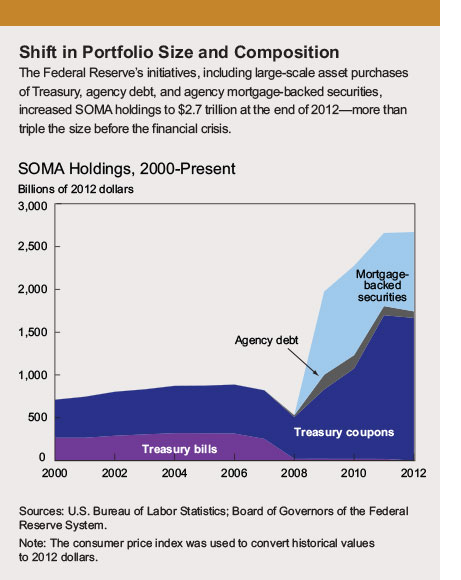-
- About the New York Fed
- What We Do
- Communities We Serve
-
More About Us
-
At the New York Fed, our mission is to make the U.S. economy stronger and the financial system more stable for all segments of society. We do this by executing monetary policy, providing financial services, supervising banks and conducting research and providing expertise on issues that impact the nation and communities we serve.

The New York Innovation Center bridges the worlds of finance, technology, and innovation and generates insights into high-value central bank-related opportunities.

Do you have a request for information and records? Learn how to submit it.

Learn about the history of the New York Fed and central banking in the United States through articles, speeches, photos and video.
-
- Markets & Policy Implementation
-
- Reference Rates
- Effective Federal Funds Rate
- Overnight Bank Funding Rate
- Secured Overnight Financing Rate
- SOFR Averages & Index
- Broad General Collateral Rate
- Tri-Party General Collateral Rate
- Desk Operations
- Treasury Securities
- Agency Mortgage-Backed Securities
- Repos
- Reverse Repos
- Securities Lending
- Central Bank Liquidity Swaps
- System Open Market Account Holdings
- Primary Dealer Statistics
- Historical Transaction Data
-
- Monetary Policy Implementation
- Treasury Securities
- Agency Mortgage-Backed Securities
- Agency Commercial Mortgage-Backed Securities
- Agency Debt Securities
- Repos & Reverse Repos
- Securities Lending
- Discount Window
- Treasury Debt Auctions & Buybacks
as Fiscal Agent - INTERNATIONAL MARKET OPERATIONS
- Foreign Exchange
- Foreign Reserves Management
- Central Bank Swap Arrangements
- ACROSS MARKETS
-
- Economic Research
- U.S. Economy
- Consumer Expectations & Behavior
- Growth & Inflation
- Economic Heterogeneity Indicators (EHIs)
- Multivariate Core Trend Inflation
- New York Fed DSGE Model
- New York Fed Staff Nowcast
- R-star: Natural Rate of Interest
- Labor Market
- Financial Stability
- Corporate Bond Market Distress Index
- Losses from Natural Disasters
- Outlook-at-Risk
- Treasury Term Premia
- Yield Curve as a Leading Indicator
- Banking
- RESEARCHERS
-
- Financial Institution Supervision
- Bank Applications
-
As part of our core mission, we supervise and regulate financial institutions in the Second District. Our primary objective is to maintain a safe and competitive U.S. and global banking system.

The Governance & Culture Reform hub is designed to foster discussion about corporate governance and the reform of culture and behavior in the financial services industry.

Need to file a report with the New York Fed? Here are all of the forms, instructions and other information related to regulatory and statistical reporting in one spot.

The New York Fed works to protect consumers as well as provides information and resources on how to avoid and report specific scams.
-
- Financial Services & Infrastructure
-
The Federal Reserve Bank of New York works to promote sound and well-functioning financial systems and markets through its provision of industry and payment services, advancement of infrastructure reform in key markets and training and educational support to international institutions.

The New York Innovation Center bridges the worlds of finance, technology, and innovation and generates insights into high-value central bank-related opportunities.

The growing role of nonbank financial institutions, or NBFIs, in U.S. financial markets is a transformational trend with implications for monetary policy and financial stability.

The New York Fed offers the Central Banking Seminar and several specialized courses for central bankers and financial supervisors.
-
- Community Development & Education
-
- Staff
-
Fed System Initiatives
- Other Community Development Work
- Calendar
-
|
The SOMA in Perspective The New York Fed's Research and Markets Groups recently teamed up on a five-part blog series covering the history and evolution of the Federal Reserve’s System Open Market Account (SOMA), a portfolio used to support implementation of monetary policy. The series, posted on Liberty Street Economics, was conceived to promote a better understanding of how the portfolio generates income, why income has increased in recent years, and why future net income from the portfolio will depend on a wide range of factors and may be more variable for a period of time.
The SOMA Portfolio through Time provides historical context on SOMA portfolio developments and the policy objectives it supports, noting that while the size and composition of the portfolio have played a more passive policy role in the years preceding the financial crisis, this hasn’t always been the case—historically or currently. A History of SOMA Income describes how net income varies over time, and how the recent high remittances to Treasury shouldn’t be considered typical. The authors explain how changes in the size and composition of the SOMA portfolio were intended to promote the Fed’s dual mandate of maximum employment and price stability, and not to produce a financial return. What If? A Counterfactual SOMA Portfolio compares the current SOMA portfolio with one in a counterfactual scenario in which the Fed responded to the financial crisis only by lowering the federal funds target rate and not expanding the size and composition of its balance sheet. More Than Meets the Eye: Some Fiscal Implications of Monetary Policy casts the fiscal implications of monetary policy in a broad context. The authors encourage readers to consider all the ways that monetary policy influences the economy, and, by extension, the government’s tax revenues and expenditures—not just the more easily observable remittances to Treasury from the Federal Reserve. Transparency and Sources of Information on the Federal Reserve’s Operations, Income, and Balance Sheet covers the various ways the public can access information on the Fed’s balance sheet, income, and operations. See also an interactive chart showing SOMA holdings between 1914 and 2012:
|


 Check out the Liberty Street Economics series:
Check out the Liberty Street Economics series: